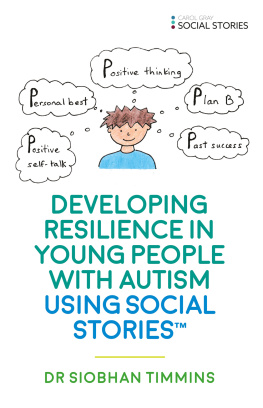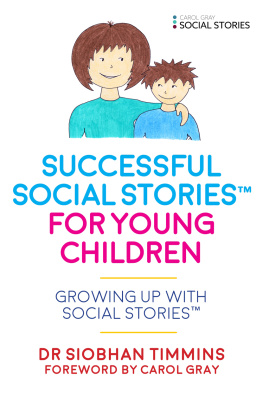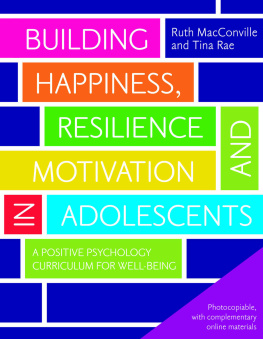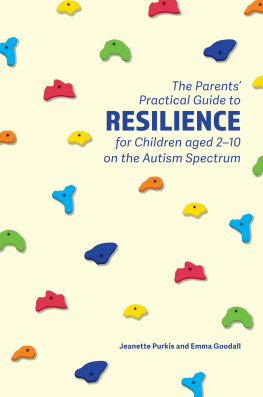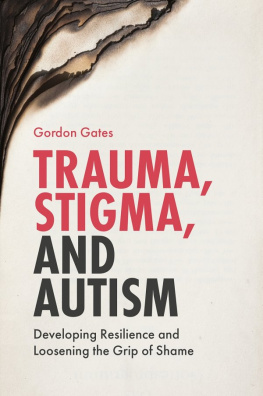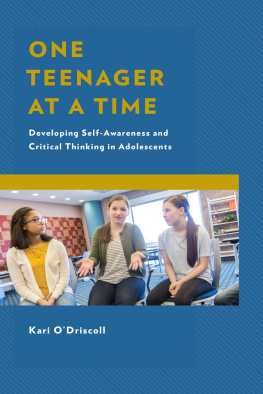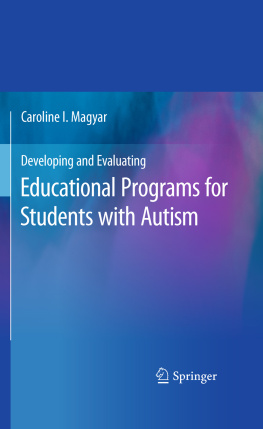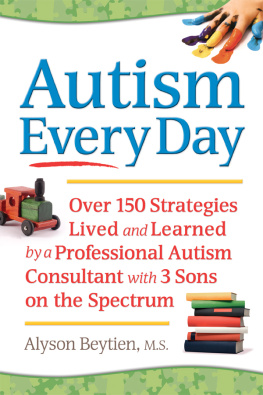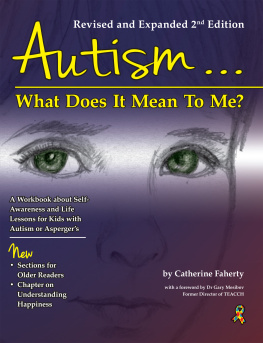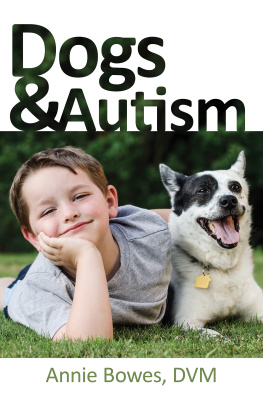
DEVELOPING
RESILIENCE IN
YOUNG PEOPLE
WITH AUTISM
USING SOCIAL
STORIES
DR SIOBHAN TIMMINS

Jessica Kingsley Publishers
London and Philadelphia
Contents
Understanding the Perspective of Young
People on the Autism Spectrum
In order to encourage the development of resilience in young people on the autism spectrum we first of all need to understand and respect their perspective of the world.
How we understand the world around us is governed by how our brain processes the vast amount of information streaming in through our senses. People on the autism spectrum process this information in a different way to people who are not on the spectrum (neurotypical people). As a result, they have a different perspective of life to neurotypical people and their responses to situations may therefore seem unexpected, unusual and sometimes even challenging to neurotypicals. Parents and professionals frequently note that the strategies that usually help neurotypical young people frequently fail for those who are on the autism spectrum. This may lead to the young person mistakenly being labelled as non-compliant or defiant. It is important to realise that this perspective of the world is as valid to the young person as our perspective is to us; it is not a choice he has made he cannot choose to perceive in a different way. In our predominantly neurotypical world, life can be very tough for those with an autistic perspective. Frequent negative social interactions and negative social experiences can lead to low self-esteem, increased anxiety and social isolation, with an impact on mental health.
There are three main validated theories that explain how neurotypical people process the clues surrounding them in order to have social understanding. Knowing how social understanding comes about helps us understand how different the perspective may be if these processes are not working as quickly or efficiently. The theories are called central coherence (Frith, 2003), theory of mind (Baron-Cohen, 1995) and executive function (Pennington and Ozonoff 1996; Goldberg et al., 2005). More recently a fourth theory has been proposed by Dr. Peter Vermeulen called context blindness (Vermeulen, 2012). This theory unifies the other theories and in addition gives an explanation of the other features of autism not completely addressed by them, namely sensory and literal language difficulties.
The theories in more detail
Central coherence/context blindness
Neurotypicals are context sensitive and have strong central coherence. This means we are able to put together the socially relevant clues in a situation in order to make social sense of it. We continually pick up information from our surroundings and from others through our senses, and our brains instantaneously process this information, identifying the gist or context of a situation. The context then focuses us only on the details that are socially relevant to that context, in preference to any other details present, in order to make social sense of a new or changing situation. All that is not socially relevant is faded into the background. Information is then matched and drawn from previous similar experiences stored in our memory. This instantly helps us with the current situation, identifying whether it is safe or dangerous, and importantly allowing us to predict what may happen next. This enables us to choose safe and effective responses to suit the situation. We do not even need to think about it this all happens subconsciously, innately and intuitively.
In contrast, young people on the autism spectrum, despite being able to notice tiny details and changes around them, do not always accurately recognise and use the context. They therefore focus on details that are socially irrelevant, but which are instead particularly interesting for them. They are missing crucial social information. This results in a lack of awareness of the sort of social situation they are currently in, and consequently they are less likely to choose a safe and effective response. Instead a response is chosen that is related to the details they have focused on, and this may seem out of place and unexpected to those neurotypicals around them. Young people on the autism spectrum require time to consciously work out the context, time that is not available in the quick to and fro of a rapidly changing social interaction or situation. They can be described as having context blindness and weak central coherence. Similarly, they often have difficulty making social sense of the clues involved in facial expressions, tone of voice and body language in other people. They may be less able to discern how these clues give an idea of the emotion that person may be currently experiencing.
As a consequence of this difficulty with context and making sense of a social situation or interaction, our young people may be less able or unable to recognise when a situation is coming to an end and a new situation is beginning. Change becomes frightening and disturbing and results in huge anxiety. In order to relieve this anxiety our children may strive to control the people and objects in the environment and keep everything the same. They may feel reassured by structure and ritual, being soothed by repetitive activities like watching the same video clip over and over perhaps the only time they can truly predict what is coming next.
Theory of mind
In addition to immediately grasping the context of a situation, neurotypicals are also able to be continually aware of what another person may be thinking, feeling, knowing or believing. This is often referred to as having theory of mind, and an absence or difficulty in this area is a common feature to all those on the autism spectrum. Having this ability allows us to be aware that we may be upsetting, annoying or boring another person and stimulates us to stop what we are doing, change topic or move away. This keeps us safe and effective in our interactions with other people. Without this ability, a young person will simply not have other peoples thoughts and feelings in mind during his interactions with others. He may continue with a conversation for example, without taking turns to listen, oblivious to the other persons upset or boredom, or he may state a fact about another persons appearance or performance that is hurtful. This makes it difficult for him to make and keep friendships. Lacking mindfulness of what other people might know may also prevent him asking for clarification or help, which means he remains confused and becomes more anxious.
Executive function
Air traffic control resides in the control tower of an airport. Here, close attention is paid to the time management, prioritisation, sequencing and planning of the take-off and landing of all the aircraft. If there is an unexpected hitch to a landing, a new plan must be very rapidly formulated for that aircraft by the control tower staff. Airplanes are never allowed to take off or land just on impulse. This keeps the airport safe and effective each day and in all weathers.
In a very similar way neurotypical executive function, which resides in our frontal lobes, works as our control tower. Executive function manages the thoughts, words and actions we send out by using impulse control, time management, prioritisation, sequencing and planning. When executive function is weak, which may often be the case in young people on the autism spectrum, the ability to control impulses, manage time, prioritise, sequence and plan is impaired. For our young people, already experiencing a world where they cannot predict what will be said or might happen next, being impaired in how they sequence and plan their way through the social world adds to the confusion.
Next page
